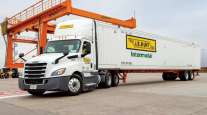Staff Reporter
Carriers Highlight Industry Issues Persisting After Volatile Year

[Ensure you have all the info you need in these unprecedented times. Subscribe now.]
Trucking companies detailed the market challenges that persist in the waning weeks of 2020 during a three-day conference on economic trends.
The Baird Global Industrial Virtual Conference included J.B. Hunt Transport Services and Werner Enterprises, which provided perspectives for the freight transportation sector.
COVID-19 and the shock waves it has sent through the economy was the focal point. J.B. Hunt discussed the pandemic and other issues during a recent conference call with its customers.
“It allowed our customers to really hear what they were feeling, which was more chaotic than expected,” J.B. Hunt Chief Commercial Officer Shelley Simpson said Nov. 10. “Primarily driven from a dislocation in shipments and capacity. That dislocation has caused significant issues in the market. Customer routing guides, or who they believe would hold freight, is failing in the one-way part of the business. Both intermodal and highway.”
J.B. Hunt executives also highlighted the feedback they were getting from its customers during their virtual session.
“They expect to be restocking inventories at least through Q1,” Simpson said. “Our customers right now feel like this environment will stay at least through the next several months in talking about what they think 2021 would look like. The other thing we talked to them about was just what was happening from a labor perspective. Labor is driving challenges across the board.”
Simpson added that labor issues have impacted warehouses and railroads along with its own operations. All these areas are having trouble finding the workers they need. It’s an issue that has affected trucking throughout the year.

Simpson
“That challenge is still here,” Simpson said. “Our routing guides are still continuing to fail. Demand has been strong, and customers are really trying to figure out how can they create a better budget for themselves in 2021 and help mitigate some of the cost pressure that they’ve seen.”
Simpson added that customers also discussed costs being a challenge and goods not moving efficiently. They asked about ways to mitigate the issues. Nick Hobbs, president of dedicated contract services at J.B. Hunt, saw similar labor constraint issues on the dedicated services and final-mile side.
“COVID really illustrated our strength to be able to adapt,” he said. “We were able to get a lot of momentum from existing customers because of what we were able to do. But also some of the private fleets we were not doing business with, we’ve seen a lot of requests.”
J.B. Hunt Transport Services Inc. ranks No. 4 on the Transport Topics Top 100 list of the largest for-hire carriers in North America. It also ranks No. 4 on the Transport Topics Top 50 list of the largest logistics companies in North America.
Werner Enterprises CEO Derek Leathers noted during a later session that the coronavirus brought the trucking industry into a new business cycle that has been defined by constraints on the supply side but also high demand. It’s a cycle the industry likely is not far into.
“I do think the cycle is different,” Leathers said Nov. 11. “It’s different for a lot of reasons. Let’s start on the supply side … The tightening that happened this time around was kicked off by different market forces.”

Leathers
He detailed how labor constraint has been one of the biggest and most immediate issues. Driver training schools were all but shut down during the start of the pandemic. But even as more have reopened, they still are socially distanced and probably will remain so indefinitely.
“We found ourselves in a world where the production rate of school networks nationwide is probably 60% in aggregate what it was before COVID,” Leathers said. “Coupled with that, you have an acceleration of retirements. People at the end of their careers also are older in age, and so they’re in a higher-risk category and we’ve seen an uptick in retirements around the industry.”
Leathers added that schools that are open are operating at about 70% what they were before the pandemic. Community colleges are mostly closed as well. He noted the impact on the aggregate is about a 60% induction rate compared to what it was before the pandemic.
“This is real,” Leathers said. “The constraints on the supply side are real. But then, on the demand side, the American consumer has come through this stronger than anyone expected, especially if you’re aligned with the right kinds of customers.”
Werner ranks No. 16 on the for-hire TT100 and No. 17 on the TT Logistics Top 50.
Want more news? Listen to today's daily briefing:
Subscribe: Apple Podcasts | Spotify | Amazon Alexa | Google Assistant | More




